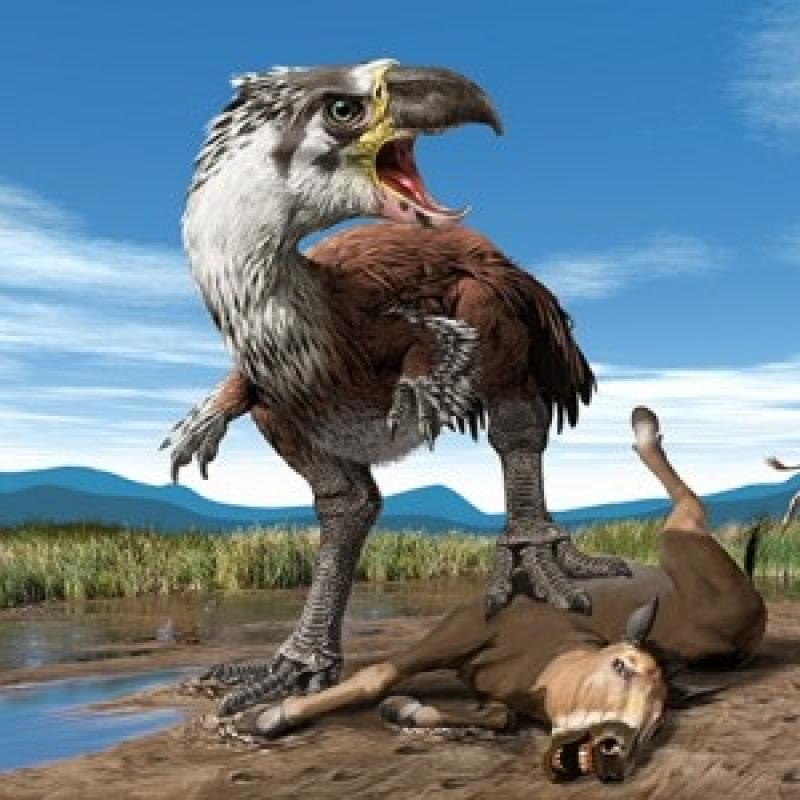How birds may have escaped the dino-killing asteroid impact



RUN, BIRD, RUN Birds most likely to have survived a mass extinction 66 million years ago would have been small (as seen in this artist’s depiction), able to fly and just fine living on the ground, researchers say.
Phillip M. Krzeminski
The asteroid impact that caused a mass extinction 66 million years probably also triggered the collapse of forests worldwide, a new investigation of the plant fossil record concludes. Needing trees and extensive plant cover for nesting or food could have been a fatal drawback for winged dinosaurs, including some ancient birds. Reconstructing the ecology of ancient birds suggests that modern fowl descended from species that survived because they could live on the ground , an international research team proposes in the June 4 Current Biology .
“You probably would have died anyway regardless of habitat,” says study coauthor Daniel Field, an evolutionary paleobiologist at the University of Bath in England. “But if you could get along on the ground, you at least had a shot at surviving across this devastated landscape.”
The shock wave from the strike probably flattened trees within a radius of 1,500 kilometers, Field says. Wildfires ignited around the planet and then came the acid rain. Clouds of ash and dust may have darkened the sky for several years, and researchers suspect that photosynthesis waned. Yet some lucky birds, but no other dinosaurs, survived the hellscape.
For clues to what made a survivor, researchers turned to fossilized pollen from before and after the fiery impact. Abundant kinds of flower-bearing and cone-bearing plants left pollen just before the asteroid hit and again starting about a thousand years afterward. In between those times of diversity, however, ferns dominated, the team notes. A kind of “disaster flora,” ferns (making spores instead of flowers and seeds) do well at recolonizing land. Seed plants, however, weren’t thriving.
Analyzing evolutionary histories of modern birds supports the idea of tree dependence as a vulnerability for the earliest fowl, the researchers say. Specialists in bird evolution now generally agree on the lowest, oldest branches of the bird family tree, Field says. The bottommost one, for instance, includes such modern species as ground-dwelling ostriches and smaller, flight-capable birds called tinamous, which might be more like the ancient birds that dodged extinction.
Working backward along these low branches, researchers used fossils and known bird traits to reconstruct the most likely lifestyles of the earliest survivors. These probably weren’t tree-dependent birds, the researchers conclude.
The glory days of dinosaurs had had plenty of flying tree-dwellers. So far, paleontologists have identified at least 80 kinds of what are called “opposite birds,” the Enantiornithes (SN: 2/4/17, p. 26) . “If you saw one flying around today, you’d say, ‘Well, that’s a bird,’ ” Field explains. Their feet looked like those of birds that perch on tree limbs, so he’s not surprised that a fossil of an opposite bird from this probably arboreal group has never been found in rock formed after the dino doomsday.
What did happen, however, was that when trees and forests came back after the disaster, birds quickly evolved arboreal lifestyles, the team says.
Many people don’t realize that birds almost died off during the mass extinction, too, says paleontologist Stephen Brusatte of the University of Edinburgh who has studied bird evolution but was not involved in the new study. What let the few survivors squeak through, he says, has been a mystery for a long time. The whole scenario of a ground-dweller’s advantage and then a return to the trees “makes a lot of intuitive sense.”






Bad hair day...
It's fascinating to watch a crow strutting around and making a racket, and realize I am looking at a dinosaur.

Too bad the Pterosaurs didn't make the cut....the largest had wingspans of 25-35 feet. Would be awe-inspiring to watch one these reptiles fly over
Corvidae are all very cool.
... ... p terodactyls , too.....
Something I always hope is recognized in articles like these are the inter-relationships of things.
Oversimplified examples by me:
Trees are gone; ground dwelling birds survive.
Trees are gone; ferns re-establish ground cover and lead to re-emergence of trees again 1,000 (!) years later.
Trees are re-established; birds again begin to fly.
This was not even the worst extinction currently understood to have happened, yet shows a fall back to the building blocks which lower life forms tend to be.
That thought holds a concern as in many areas lower life form are put at risk.
It's the time-scale that always leaves me amazed....